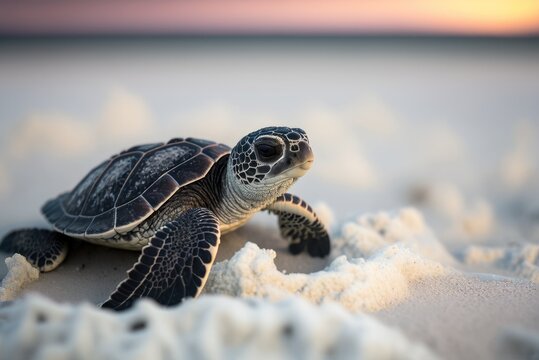
Baby Turtles: A Journey from Egg to Ocean
In the realm of nature’s wonders, the life cycle of a baby turtle is a captivating spectacle that unfolds over several years. These tiny creatures, emerging from their protective shells, embark on an extraordinary journey filled with challenges and triumphs. From their humble beginnings in sandy nests to their perilous swim to the open ocean, baby turtles face a myriad of obstacles that test their resilience and determination.
Hatching: A Moment of Emergence
The journey of a baby turtle begins within a buried nest, where eggs incubate for weeks or even months. As the time for hatching approaches, the tiny turtles, guided by an internal egg tooth, begin to break free from their protective shells. Using their powerful flippers, they dig their way to the surface, eager to explore the world beyond their sandy confines.
First Steps: A Race Against Time
Once hatched, baby turtles face their first major challenge: reaching the ocean before they succumb to predators or dehydration. With a burst of energy, they scramble towards the nearest body of water, their tiny flippers propelling them forward. This perilous journey can take hours or even days, as they navigate through obstacles such as vegetation, dunes, and hungry predators.
The Ocean’s Embrace: A New Frontier
Upon reaching the ocean, baby turtles enter a vast and unforgiving environment. They are immediately swept away by currents and tides, carried far from their birthplace. This dispersal mechanism helps ensure the survival of the species by preventing overcrowding and competition for resources.
Pelagic Life: A Sea of Challenges
In the open ocean, baby turtles face a myriad of challenges. They must contend with predators such as sharks, birds, and fish, while also navigating through treacherous currents and storms. To survive, they rely on their camouflage and their ability to dive deep into the water to avoid danger.
Feeding: A Constant Pursuit
Baby turtles are voracious eaters, consuming a wide variety of food sources. Their diet includes jellyfish, plankton, small fish, and crustaceans. They spend much of their time searching for food, using their keen eyesight and sense of smell to locate prey.
Growth and Development: A Gradual Transformation
As baby turtles grow, they undergo a gradual transformation. Their shells harden and become more protective, while their flippers become stronger and more efficient. They also develop a layer of scales that helps them regulate their body temperature.
Return to Shore: A Distant Memory
After several years spent in the open ocean, baby turtles reach sexual maturity and begin to migrate back to the shores where they were born. Guided by an innate sense of direction, they navigate thousands of miles to return to their nesting grounds.
Nesting: A Cycle of Life
Once they reach the shore, female turtles dig nests in the sand and lay their eggs. The cycle of life begins anew as the next generation of baby turtles emerges from their shells and embarks on their own extraordinary journey.
Conservation: Protecting a Vulnerable Species
Baby turtles face numerous threats to their survival, including habitat loss, pollution, and climate change. Conservation efforts are crucial to protect these vulnerable creatures and ensure the continuation of their species. Measures such as beach cleanups, nest protection, and reducing plastic pollution play a vital role in safeguarding the future of baby turtles.
Conclusion
The life cycle of a baby turtle is a testament to the resilience and determination of these remarkable creatures. From their humble beginnings in sandy nests to their perilous swim to the open ocean and their eventual return to shore, baby turtles face a myriad of challenges that test their limits. Through conservation efforts and a greater understanding of their biology, we can help ensure that these magnificent animals continue to thrive for generations to come.
